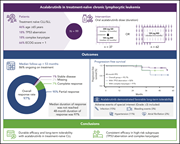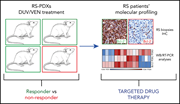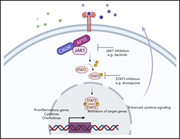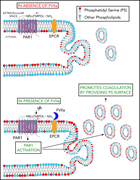Issue Archive
Table of Contents
BLOOD COMMENTARIES
CLINICAL TRIALS AND OBSERVATIONS
Acalabrutinib in treatment-naive chronic lymphocytic leukemia
Clinical Trials & Observations
Byrd and colleagues report the results of a phase 1/2 trial assessing the second-generation Bruton tyrosine kinase (BTK) inhibitor acalabrutinib in 99 previously untreated patients with chronic lymphocytic leukemia (CLL). One hundred milligrams twice daily is confirmed as the most appropriate dosing schedule on the basis of trough BTK occupancy levels. After a median follow-up exceeding 4 years, 86% of patients remain on therapy, suggesting high efficacy (97% response rate, including 7% complete responses) and acceptable tolerability, with 5% of patients experiencing atrial fibrillation and 22% experiencing hypertension.
HEMATOPOIESIS AND STEM CELLS
Radiation-induced bystander effects impair transplanted human hematopoietic stem cells via oxidative DNA damage
Radiation-induced bystander effects (RIBEs) are recognized as part of the radiation response and may impair hematopoietic stem cell (HSC) transplantation by radiation-induced damage to the HSC niche. Using xenograft models, Hu and colleagues reveal that RIBEs induce oxidative DNA damage that contributes to impairment of human HSC reconsitution. Antioxidants can partially mitigate this effect in vivo, suggesting a potential strategy to enhance engraftment.
LYMPHOID NEOPLASIA
Impaired ribosome biogenesis checkpoint activation induces p53-dependent MCL-1 degradation and MYC-driven lymphoma death
ROR1 targeting with the antibody-drug conjugate VLS-101 is effective in Richter syndrome patient–derived xenograft mouse models
Richter syndrome (RS) is a dire complication of chronic lymphocytic leukemia (CLL) and lacks a proven therapy. While usually clonally related to the preceding CLL, RS rarely responds to the targeted agents that have transformed CLL management. Iannello and colleagues report that phosphoinositide 3-kinase inhibitors can sensitize RS samples from patients to BCL2 inhibitors by regulating expression of antiapoptotic molecules via GSK3β, suggesting that simultaneous treatment with duvelisib and venetoclax warrants evaluation in patients. Vaisitti and collegues reveal that receptor tyrosine kinase–like orphan receptor 1 (ROR1) is a potential therapeutic target in RS, showing a significant therapeutic effect of the ROR1-directed antibody-drug conjugate VLS-101 in a xenograft model. These 2 reports provide the rationale for 2 ongoing early-phase clinical trials.
Synergistic efficacy of the dual PI3K-δ/γ inhibitor duvelisib with the Bcl-2 inhibitor venetoclax in Richter syndrome PDX models
Richter syndrome (RS) is a dire complication of chronic lymphocytic leukemia (CLL) and lacks a proven therapy. While usually clonally related to the preceding CLL, RS rarely responds to the targeted agents that have transformed CLL management. Iannello and colleagues report that phosphoinositide 3-kinase inhibitors can sensitize RS samples from patients to BCL2 inhibitors by regulating expression of antiapoptotic molecules via GSK3β, suggesting that simultaneous treatment with duvelisib and venetoclax warrants evaluation in patients. Vaisitti and collegues reveal that receptor tyrosine kinase–like orphan receptor 1 (ROR1) is a potential therapeutic target in RS, showing a significant therapeutic effect of the ROR1-directed antibody-drug conjugate VLS-101 in a xenograft model. These 2 reports provide the rationale for 2 ongoing early-phase clinical trials.
MYELOID NEOPLASIA
Cytokine-like protein 1–induced survival of monocytes suggests a combined strategy targeting MCL1 and MAPK in CMML
A JAK/STAT-mediated inflammatory signaling cascade drives oncogenesis in AF10-rearranged AML
The AF10 gene is recurrently involved in chromosomal translocations in uncommon acute myeloid leukemias (AMLs) with adverse outcomes. Chen and colleagues comprehensively characterized AF10 fusion proteins to identify downstream transcriptional networks and protein interactors. They demonstrate that AF10 fusion proteins recruit JAK1 and that JAK1 activity is important in leukemogenesis, suggesting a novel experimental therapeutic approach for these AMLs.
PHAGOCYTES, GRANULOCYTES, AND MYELOPOIESIS
HIF2α is a direct regulator of neutrophil motility
As key cellular mediators in inflammation, neutrophils carry out their roles in a hypoxic environment. Sormendi et al identified for the first time a mechanistic link between the PHD2 oxygen sensor, the transcription factor hypoxia-inducible factor 2 (HIF-2), RhoA, and neutrophil migration in highly constrained matrices akin to tightly confined inflamed tissues. They implicate stabilization of HIF-2 as an important promoter of neutrophil motility during inflammation.
THROMBOSIS AND HEMOSTASIS
Factor VIIa induces extracellular vesicles from the endothelium: a potential mechanism for its hemostatic effect
The canonical function of factor VIIa (FVIIa) is to bind its cofactor tissue factor (TF) and activate coagulation factor X (FX), the enzyme responsible for the production of thrombin. Das and colleagues report an ancillary new hemostatic mechanism of recombinant fVIIa (rFVIIa) that also induces extracellular vesicle release by endothelial cells. These phosphatidylserine-containing membranes enable TF-independent FX activation by rFVIIa and can contribute to in vivo hemostatic activity in murine models of bleeding in hemophilia and severe thrombocytopenia.
Structural characterization of a novel GPVI-nanobody complex reveals a biologically active domain-swapped GPVI dimer
The platelet receptor glycoprotein VI (GPVI) plays a central role in arterial thrombosis and is a promising target for novel antiplatelet therapies. Slater et al report a new GPVI dimer structure and, by identifying a critical region in the D2 domain mediating GPVI signaling, provide new mechanistic insight into GPVI activation.
LETTER TO BLOOD
Primary resistance to CD19-directed chimeric antigen receptor T-cell therapy in T-cell/histiocyte-rich large B-cell lymphoma
BLOOD WORK
-
Cover Image
Cover Image
![issue cover]()
Cleaved caspase-3 immunohistochemistry staining on a tumor mass from a patient-derived xenograft model of Richter syndrome. Treatment with the combination of duvelisib and venetoclax induces apoptosis in Richter syndrome cells. See the article by Iannello et al on page 3378.
- PDF Icon Front MatterFront Matter
- PDF Icon Table of ContentsTable of Contents
- PDF Icon Back MatterBack Matter
- PDF Icon Editorial BoardEditorial Board
Advertisement intended for health care professionals
Email alerts
Advertisement intended for health care professionals













On the road to optimized BTK inhibition in CLL
Clinical Trials & Observations